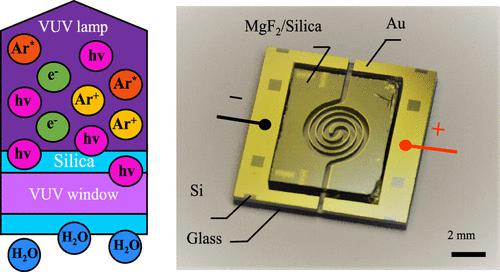当前位置:
X-MOL 学术
›
Anal. Chem.
›
论文详情
Our official English website, www.x-mol.net, welcomes your feedback! (Note: you will need to create a separate account there.)
Ultrathin Silica Integration for Enhancing Reliability of Microfluidic Photoionization Detectors
Analytical Chemistry ( IF 7.4 ) Pub Date : 2023-05-24 , DOI: 10.1021/acs.analchem.3c00354 Xiaheng Huang 1, 2, 3, 4 , Ruchi Sharma 1, 3, 4 , Anjali Devi Sivakumar 1, 2, 3, 4 , Shuo Yang 1, 3, 4 , Xudong Fan 1, 3, 4
Analytical Chemistry ( IF 7.4 ) Pub Date : 2023-05-24 , DOI: 10.1021/acs.analchem.3c00354 Xiaheng Huang 1, 2, 3, 4 , Ruchi Sharma 1, 3, 4 , Anjali Devi Sivakumar 1, 2, 3, 4 , Shuo Yang 1, 3, 4 , Xudong Fan 1, 3, 4
Affiliation

|
Microfluidic photoionization detectors (μPIDs) based on silicon chips can rapidly and sensitively detect volatile compounds. However, the applications of μPID are limited by the manual assembly process using glue, which may outgas and clog the fluidic channel, and by the short lifetime of the vacuum ultraviolet (VUV) lamps (especially, argon lamps). Here, we developed a gold–gold cold welding-based microfabrication process to integrate ultrathin (10 nm) silica into μPID. The silica coating enables direct bonding of the VUV window to silicon under amicable conditions and works as a moisture and plasma exposure barrier for VUV windows that are susceptible to hygroscopicity and solarization. Detailed characterization of the silica coating was conducted, showing that the 10 nm silica coating allows 40–80% VUV transmission from 8.5 to 11.5 eV. It is further shown that the silica-protected μPID maintained 90% of its original sensitivity after 2200 h of exposure to ambient (dew point = 8.0 ± 1.8 °C), compared to 39% without silica. Furthermore, argon plasma inside an argon VUV lamp was identified as the dominant degradation source for the LiF window with color centers formation in UV–vis and VUV transmission spectra. Ultrathin silica was then also demonstrated effective in protecting the LiF from argon plasma exposure. Lastly, thermal annealing was found to bleach the color centers and restore VUV transmission of degraded LiF windows effectively, which will lead to future development of a new type of VUV lamp and the corresponding μPID (and PID in general) that can be mass produced with a high yield, a longer lifetime, and better regenerability.
中文翻译:

用于提高微流控光电离检测器可靠性的超薄二氧化硅集成
基于硅芯片的微流控光电离检测器 (μPID) 可以快速、灵敏地检测挥发性化合物。然而,μPID 的应用受到使用胶水的手动组装过程的限制,胶水可能会排出气体并堵塞流体通道,以及真空紫外线 (VUV) 灯(尤其是氩灯)的短寿命。在这里,我们开发了一种基于金-金冷焊的微细加工工艺,将超薄(10 nm)二氧化硅集成到 μPID 中。二氧化硅涂层能够在友好条件下将 VUV 窗口直接键合到硅上,并作为易吸湿和日晒的 VUV 窗口的水分和等离子体暴露屏障。对二氧化硅涂层进行了详细表征,表明 10 nm 的二氧化硅涂层允许 40-80% 的 VUV 透射率从 8.5 到 11.5 eV。进一步表明,在暴露于环境(露点 = 8.0 ± 1.8 °C)2200 小时后,二氧化硅保护的 μPID 保持其原始灵敏度的 90%,而没有二氧化硅时为 39%。此外,氩 VUV 灯内的氩等离子体被确定为 LiF 窗口的主要降解源,在 UV-vis 和 VUV 透射光谱中形成色心。然后还证明超薄二氧化硅可有效保护 LiF 免受氩等离子体暴露。最后,发现热退火可以漂白色心并有效恢复劣化 LiF 窗口的 VUV 传输,这将导致未来开发新型 VUV 灯和相应的 μPID(以及一般的 PID),可以用产量高、寿命长、再生性好。
更新日期:2023-05-24
中文翻译:

用于提高微流控光电离检测器可靠性的超薄二氧化硅集成
基于硅芯片的微流控光电离检测器 (μPID) 可以快速、灵敏地检测挥发性化合物。然而,μPID 的应用受到使用胶水的手动组装过程的限制,胶水可能会排出气体并堵塞流体通道,以及真空紫外线 (VUV) 灯(尤其是氩灯)的短寿命。在这里,我们开发了一种基于金-金冷焊的微细加工工艺,将超薄(10 nm)二氧化硅集成到 μPID 中。二氧化硅涂层能够在友好条件下将 VUV 窗口直接键合到硅上,并作为易吸湿和日晒的 VUV 窗口的水分和等离子体暴露屏障。对二氧化硅涂层进行了详细表征,表明 10 nm 的二氧化硅涂层允许 40-80% 的 VUV 透射率从 8.5 到 11.5 eV。进一步表明,在暴露于环境(露点 = 8.0 ± 1.8 °C)2200 小时后,二氧化硅保护的 μPID 保持其原始灵敏度的 90%,而没有二氧化硅时为 39%。此外,氩 VUV 灯内的氩等离子体被确定为 LiF 窗口的主要降解源,在 UV-vis 和 VUV 透射光谱中形成色心。然后还证明超薄二氧化硅可有效保护 LiF 免受氩等离子体暴露。最后,发现热退火可以漂白色心并有效恢复劣化 LiF 窗口的 VUV 传输,这将导致未来开发新型 VUV 灯和相应的 μPID(以及一般的 PID),可以用产量高、寿命长、再生性好。


























 京公网安备 11010802027423号
京公网安备 11010802027423号